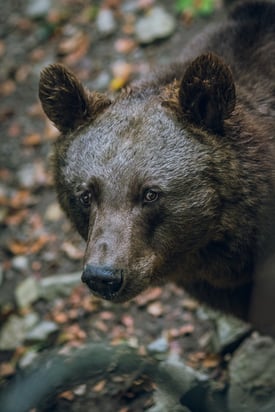A blog post by Melissa Ruisz Nazario, based on an interview with Stacey Shelby, RCC, Ph.D., conducted by Bonnie Bright, Ph.D.
Listen to the full audio interview with Stacey Shelby here. (approx. 30 minutes)
![]()
At first, Stacey Shelby, RCC, Ph.D., didn't want to explore the Wild Woman Archetype for her research while in the M.A./Ph.D. Program in Depth Psychology with Specialization in Jungian and Archetypal Studies at Pacifica Graduate Institute. Part of it was due to the type of research she would conduct and the effect it would have on her life. When authoring the book Tracking the Wild Woman Archetype: A Guide to Becoming a Whole, In-divisible Woman published earlier this year, she used a research methodology called alchemical hermeneutics, as described by Dr. Robert Romanyshyn, Pacifica Graduate Institute Professor Emeritus, in his book, The Wounded Researcher: Research with Soul in Mind.
In the introduction to Tracking the Wild Woman Archetype, Stacey defines alchemical hermeneutics as “an unconventional methodology not readily found in traditional academic institutions, and it acknowledges that researchers are often called to their work through personal wounding and complexes. This research methodology is an alchemical process that affects the researcher.”
Stacey says she at first resisted researching the Wild Woman archetype, coined by Dr. Clarissa Pinkola Estés in the groundbreaking book, Women Who Run with The Wolves: Myths and Stories of the Wild Woman Archetype, specifically because she knew it would change her. She admitted that it was her ego, doing its job of protecting the Self, that resisted the inevitable change and journey into the unknown that she knew would occur if she proceeded.
“The ego is just not terribly fond of change; it likes to keep us safe, right?” she says. “That’s its job. It’s trying to protect us. It’s trying to be very helpful, but at a certain point, we do have to transform. And I knew that going down this path was going to do that, and so there was a lot of resistance to do it.”
It is usually when we resist against what’s happening, or what we are being called to do, Stacey observes, that we’re going to suffer. Instead, if we do our best to surrender into our circumstances and try to stay aware of the process, and “really somatically staying with our breath when it gets really intense, not going into fight or flight or at least starting to recognize when we’re going into fight or flight, you know and all of the negative self-talk,” then we’ll suffer less, Stacey suggests.
Early on in her dissertation process at Pacifica Graduate Institute, Stacey had been considering research on plant medicine and plant spirits, having studied shamanic traditions and seeing that research area's connections with depth psychological traditions and archetypes. So, what pulled her away from that research onto the path of tracking the Wild Woman archetype? In one word, bears. Or rather, dreams of bears.
 Stacey recalls that she was seeing bears frequently in her waking life in Squamish, British Columbia, and at one point saw four bears in one day. But bears were showing up constantly in her dreams as well, causing her to reflect on their symbolism. Then one night, she had a particularly poignant dream, in which a mama bear, who was with her cubs at the edge of her farmstead, looked at her and followed her into her home. Stacey said she hid in a small box in her kitchen that she could barely fit in, and the bear went through the flimsy kitchen screen door and started peeking in the small box where she was hiding. Then the bear stood up, and Stacey says she not only recognized the bear, but then realized that she was looking at herself, that the bear was her.
Stacey recalls that she was seeing bears frequently in her waking life in Squamish, British Columbia, and at one point saw four bears in one day. But bears were showing up constantly in her dreams as well, causing her to reflect on their symbolism. Then one night, she had a particularly poignant dream, in which a mama bear, who was with her cubs at the edge of her farmstead, looked at her and followed her into her home. Stacey said she hid in a small box in her kitchen that she could barely fit in, and the bear went through the flimsy kitchen screen door and started peeking in the small box where she was hiding. Then the bear stood up, and Stacey says she not only recognized the bear, but then realized that she was looking at herself, that the bear was her.
As she worked more and more with this dream, Stacey not only realized that the symbol of the bear and the Wild Woman archetype were interchangeable for her personally, but that this was the direction that she needed to go in her research.
So, then, what is the Wild Woman Archetype? It’s rather mysterious and slippery to define, Stacey has observed, and any clear definition would then render it “fixed,” which this particular archetype resists. While she dedicated an entire chapter to its definition in her book, Stacey personally defines the Wild Woman Archetype as “an expression of a woman’s soul, the true authentic experience of who each individual woman is.” It is also closely related to the instinct and the body, with “a really deep sense of embodiment that the Wild Woman speaks to us through.”
The role of the Wild Woman in each person’s path toward individuation, Stacey says, seems to happen through a struggle of some kind, often starting in our 30s. Whether the struggle occurs through some sort of wonderful event, like the birth of a child, or a more negative circumstance, such as a disease or a death or an end of a relationship, “it just causes us to reevaluate everything we thought we knew,” Stacey says. “We are no longer ego-centric. We start to become aware of something else other than us. And I think that something else is the Wild Woman archetype. So, we reevaluate who we are, what our individual values are, what our ideals are, what is okay for us, what is not okay for us, what we’ll stand for, what we won’t stand for, you know, in concrete terms of relationships.”
 “You know, everything that we thought we knew gets called into question and we differentiate our personal identity at that more soulful level from the cultural values that we would have appropriated completely unconsciously," Stacey explains. "So, that individuation with the Wild Woman Archetype causes us to find out who we are differentiated from culture, in part. That’s a part of it. There’s obviously more with individuation, but that’s an important part that working with the Wild Woman involves.”
“You know, everything that we thought we knew gets called into question and we differentiate our personal identity at that more soulful level from the cultural values that we would have appropriated completely unconsciously," Stacey explains. "So, that individuation with the Wild Woman Archetype causes us to find out who we are differentiated from culture, in part. That’s a part of it. There’s obviously more with individuation, but that’s an important part that working with the Wild Woman involves.”
When asked why she chose the word “In-divisible” with a hyphen in the subtitle of her book, Stacey explains that this is another way that Jung defined individuation. That is, we’re no longer divided. “So, opposites within our Selves, paradoxes, become held, usually within some sort of symbol," she explains. "And of course, the mandala, the circle, is the symbol of wholeness and totality, what Jung calls the Self, or the personality, the whole personality, including conscious and unconscious.”
Individuation, or being in-divisible or whole, happens “when we reconcile all these opposites within ourselves: conscious and unconscious, male and female, black and white, good and bad,” Stacey says. “As we get more and more of these paradoxes reconciled within our Selves, we become whole, and we can hold all of our personality so much better.”
Although it is impossible to ever become fully conscious of all that is in the unconscious, Stacey makes the point that we can at least become conscious of the idea that there is an unconscious, which “has a tremendous amount of effect on our life. So, this in-divisible word is about becoming whole and unshakeable in our own foundation of our soul or our Self.”

Stacey Shelby, Ph.D., is the author of Tracking the Wild Woman Archetype: A Guide to Becoming a Whole, In-divisible Woman. She is also a speaker and depth psychotherapist. She is also a Registered Clinical Counselor (RCC) in Canada, a certified clinical dream tender, and she has studied in shamanic and yoga traditions. She holds a masters and Ph.D. in Depth Psychology with a specialization in Jungian and Archetypal Studies from Pacifica.
Dr. Shelby has a thriving clinical practice in Squamish, British Columbia, where she works with adults in various stages of personal transformation in person and via internet. She is gifted at working with the symbolic language of the soul and she is dedicated to honoring the soul as it presents in the lived experience of daily life.
Websites: http://drstaceyshelby.com/
Dr. Stacey Shelby on Pinterest

Melissa Ruisz Nazario is a graphic designer and social media consultant for Pacifica Graduate Institute. She is also the production manager and webmaster for Immanence Journal. In 2006, Melissa earned an M.A. in English and American Literature at The University of Texas at El Paso. Her thesis, “Parting the Shadowy Veil: Trauma, Testimony, and Shadow in Toni Morrison’s Beloved” received UTEP’s 2006 Honors Convocation Award for Outstanding English Thesis. Melissa has served as a content editor and graphic designer for the U.S. Marine Corps Public Affairs Department in Okinawa, Japan, as well as a technical writer and quality assurance specialist for Advanced Computer Learning Company in North Carolina. As an educator, she has taught college-level literature, composition, and drama; she also taught English as a second language to adults and children in Japan.
 Bonnie Bright, Ph.D., earned her doctorate in Depth Psychology at Pacifica Graduate Institute. She is the founder of Depth Psychology Alliance, a free online community for everyone interested in depth psychologies, and of DepthList.com, a free-to-search database of Jungian and depth psychology-oriented practitioners. She is also the creator and executive editor of Depth Insights, a semi-annual scholarly journal, and regularly produces audio and video interviews on depth psychological topics. Bright is especially interested in ecopsychology, dream work, and divination, and has completed 2-year certifications in Archetypal Pattern Analysis via the Assisi Institute and in Indigenous African Spiritual Technologies with West African elder Malidoma Somé. She has also trained extensively in Holotropic Breathwork™ and the Enneagram.
Bonnie Bright, Ph.D., earned her doctorate in Depth Psychology at Pacifica Graduate Institute. She is the founder of Depth Psychology Alliance, a free online community for everyone interested in depth psychologies, and of DepthList.com, a free-to-search database of Jungian and depth psychology-oriented practitioners. She is also the creator and executive editor of Depth Insights, a semi-annual scholarly journal, and regularly produces audio and video interviews on depth psychological topics. Bright is especially interested in ecopsychology, dream work, and divination, and has completed 2-year certifications in Archetypal Pattern Analysis via the Assisi Institute and in Indigenous African Spiritual Technologies with West African elder Malidoma Somé. She has also trained extensively in Holotropic Breathwork™ and the Enneagram.



